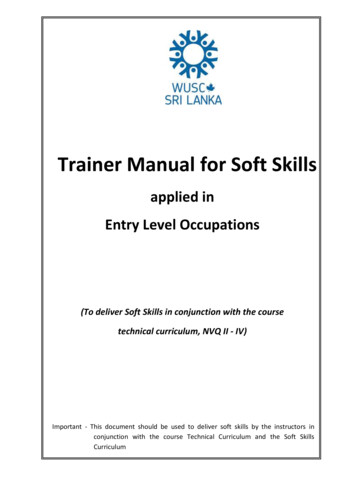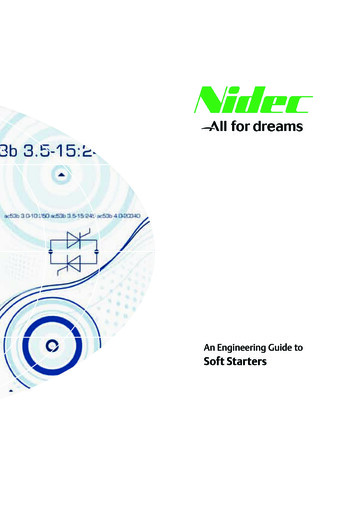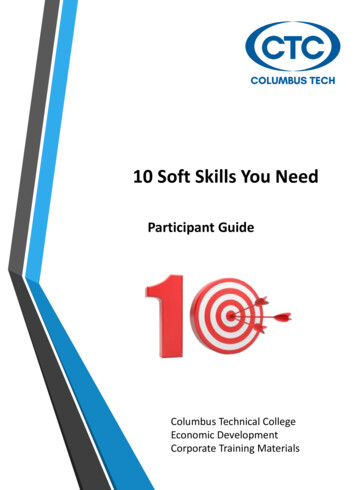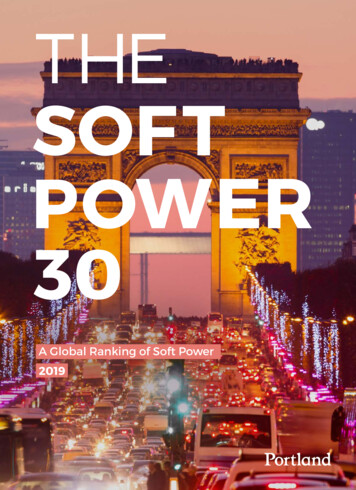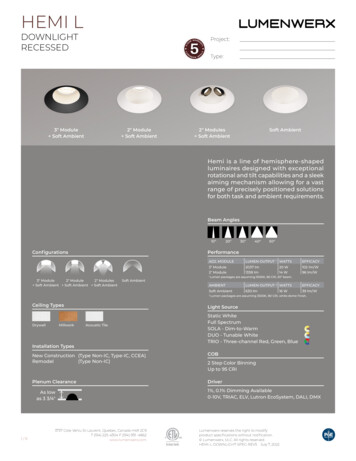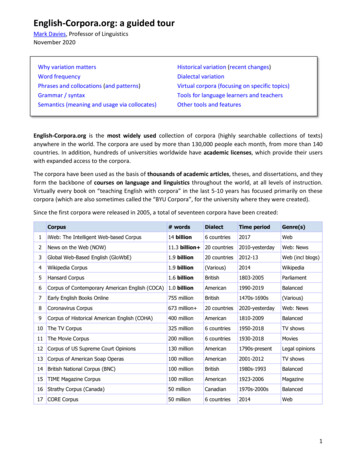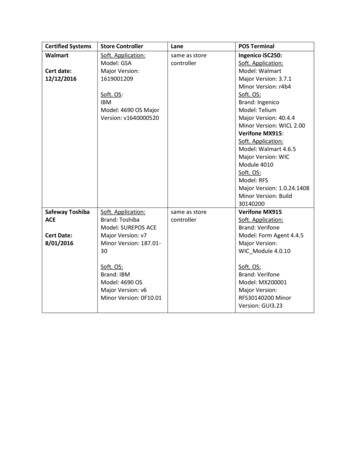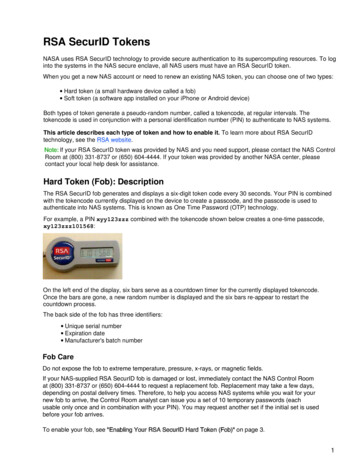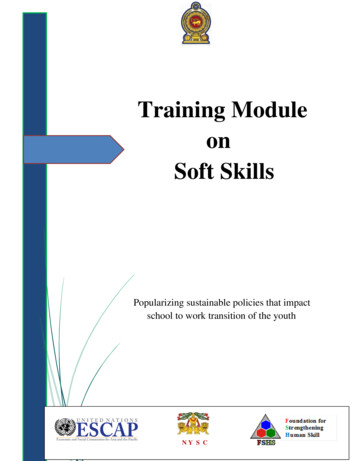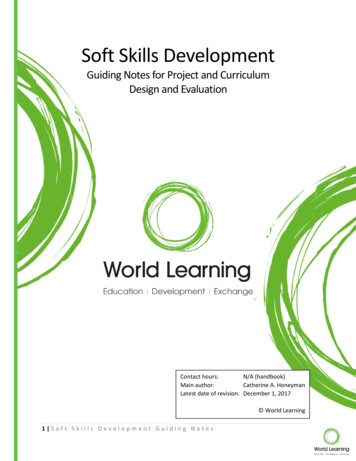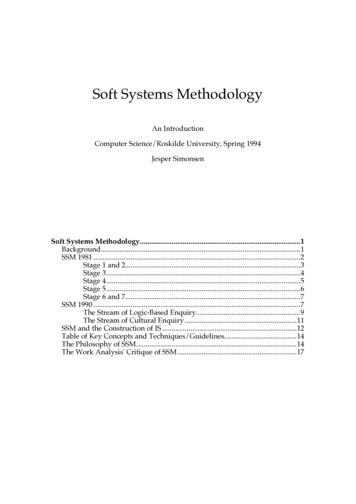
Transcription
Soft Systems MethodologyAn IntroductionComputer Science/Roskilde University, Spring 1994Jesper SimonsenSoft Systems Methodology.1Background.1SSM 1981 .2Stage 1 and 2.3Stage 3.4Stage 4.5Stage 5.6Stage 6 and 7.7SSM 1990 .7The Stream of Logic-Based Enquiry.9The Stream of Cultural Enquiry .11SSM and the Construction of IS .12Table of Key Concepts and Techniques/Guidelines.14The Philosophy of SSM.14The Work Analysis' Critique of SSM.17
Soft Systems Methodology – An Introduction,Jesper Simonsen 1Soft Systems MethodologyThis is a note for the lecture on Checkland's Soft System Methodology (SSM)held on March 29, 2000 on Department of Computer Science, RoskildeUniversity. It is a short introduction to SSM based on two primary literature's,-Checkland, Peter: Systems Thinking, Systems Practice. Chichester, WestSussex, UK, 1981, (referred to as SSM, 81), and-Checkland, Peter, and Ji Scholes: Soft Systems Methodology in Action.Chichester, West Sussex, UK, 1990, (referred to as SSM, 90).First some background for SSM is given followed by a description of SSM asdescribed in (SSM, 81) and the revised SSM as described in (SSM, 90). SSM andthe construction of Information Systems (IS) is briefly mentioned and, as asummary, a table of key concepts and techniques/guidelines is presented.Finally, the philosophy of SSM and the Work Analysis' critique of SSM isdescribed.BackgroundSSM was developed in the 1970s by Peter Checkland and others at Departmentof Systems, University of Lancaster. The SSM approach stems from the 'systemsmovement', which Checkland see as an attempt to give holistic approaches toproblems, which the traditionally reductionistic approach within naturalscience has failed to solve. The systems movement can be located withindisciplines as Biology, Ecology, Economics, Geography, Demography,Management (Operational Research), Engineering, and Cybernetics.Checkland distinguish between 'hard' and 'soft' systems thinking within theattempt to use system concepts to solve problems.Hard systems thinking is identified within Systems Engineering (as the traditional research strategy or design approach for engineers and technologists)and Systems Analysis (as the systematic appraisal of the costs and otherimplications of meeting a defined requirement in various ways).SE [Systems Engineering] is the totality of an engineering project in the broadest sense ofthat term; SA [Systems Analysis] is a type of appraisal relevant both to the decisionmaking which ought to proceed the setting up of any engineering project and to the earlystages of such a project once it is started (SSM, 81, p. 138)Hard systems thinking has the starting point in 'structured' problems and theassumption that the objectives of the systems concerned are well defined andconsistent.[A]t the core of both SE and SA, is the single idea which links them, the idea that animportant class of real-world problems can be formulated in the following way: there is adesired state, S1, and a present state, S0, and alternative ways of getting from S0 to S1.'Problem solving', according to this view, consists of defining S1 and S0 and selecting thebest means of reducing the differences between them. Thus, in SE, (S1 - S0) defines the
Soft Systems Methodology – An Introduction,Jesper Simonsen 2'need', or the objective to be attained, and SA provides an ordered way of selecting thebest among the alternative systems which could fulfil that need. The belief that real-worldproblems can be formulated in this way is the distinguishing characteristic of all 'hard' systemsthinking, whether it emerges from SE or SA. (SSM, 81, p. 138)All problems ultimately reduce to the evaluation of the efficiency of alternative means fora designated set of objectives. (Ackoff, 571 quoted from SSM, 81, p. 155)Soft systems thinking has the starting point in 'unstructured' problems withinsocial activity systems in which there is felt to be an ill-defined problemsituation.It became clear that the present research was to be concerned not with problems as suchbut with problem situations in which there are felt to be unstructured problems, ones inwhich the designation of objectives is itself problematic (SSM, 81, p. 155)Checkland refers to hard systems thinking as the 'optimization paradigm' whilesoft systems thinking is referred to as the 'learning paradigm' (SSM, 81, p. 258).The core of SSM is to use and apply systems ideas developed within hardsystems thinking in "soft" situations: in problem solving in the typicallysituation where management in an organization wants to improve a situationand the problems and the situation itself only can be stated in very general andvague terms. Hence SSM is an approach which in a systematic way tries toestablish and structure a debate concerning actions for improving the problemsituation.A main outcome of the work [.] emerges from research experiments as a system-basedmeans of structuring a debate, rather than as a recipe for guaranteed efficient achievement.(SSM, 81 p. 150)SSM is seen as a general problem-solving approach appropriate to humanactivity systems, where the starting point of the methodology does not take aproblem or a need as given (SSM, 81, p. 191).SSM 1981SSM was in Checkland's book from 1981 (SSM, 81) summarized in a diagramwith 7 stages which later literature often has referenced, see figure 1.1Ackoff, R. L. (1957): "Towards a Behavioural Theory of Communication", in Buckley, W.(Ed.): Modern Systems Research for the Behavioural Scientist, Chicago: Aldine. 1968.
Soft Systems Methodology – An Introduction,Jesper Simonsen 3Figure 1: The methodology in summary (SSM, 81 p. 163)It is emphasized, though, that SSM should not be treated as a technique (interms of a recipe) or a method, but as a methodology.My sense of the word [methodology] here is that the outcome of the research is not amethod but set of principles of method which in any particular situation have to be reducedto a method uniquely suitable to that particular situation. (SSM, 81 pp. 161f)As indicated in figure 1, SSM deals with two kinds of activity, 'real-world'activities involving people in the problem situation and 'systems thinking'activities where the analyst (in some way) tries to abstract from the real worlddoing his systems thinking and where people from the problem situation mayor may not participate.In the following each of the 7 stages are described as an ideal stage by stageprocess. The person doing (or in charge) of the methodology is referred to as'the analyst' even though this could involve people from the problem situation.Stage 1 and 2In stage 1 and 2 the analyst tries to develop the richest picture possible of theproblematic situation. The function of these 2 stages is "to display the situation sothat a range of possible and, hopefully, relevant choices [of relevant systems to bedescribed in the following stages] can be revealed" (SSM, 81 p. 166).Checkland does not provide any examples or descriptions of rich pictures inthe book from 1981. Rich pictures are later (e.g. in SSM, 90) known as somekind of informal drawings (together with describing text).
Soft Systems Methodology – An Introduction,Jesper Simonsen 4Focus in stage 1 and 2 is recommended to be on relatively stable (slow-tochange) structures and on continuously-changing processes and the relationship between structure and process.'Structure' may be examined in terms of physical layout, power hierarchy, reportingstructure, and the pattern of communications both formal and informal. 'Process' mayfrequently be examined in terms of the basic activities of deciding to do something, doingit, monitoring both how well it is done and its external effects, and taking appropriatecorrective action. (SSM, 81, p. 166)Stage 3In stage 3 the analyst moves from the real world to systems thinking.Following the development of rich pictures of the problem situation the analystnow chooses one or more short descriptions (typically 3-10 lines of text) of thereal world to model in the succeeding stage. This is referred to as 'rootdefinitions' of relevant systems (SSM, 81 pp. 166ff).As a guideline for making the root definitions Checkland present themnemonic 'CATWOE', which describes 6 elements that the root definitionought to include (SSM, 81 pp. 224ff):-C: the Customers of the system referring to the interest groups who are thebeneficiaries or victims within and/or without the system and who areaffected by the systems activities.-A: the Actors within the system who carry out or cause to be carried out themain activities of the system.-T: the Transformation process by which the inputs to the system aretransferred into defined outputs.-W: the Weltanschauung or perspective from which the root definition isseen.-O: the Owners of the system who have the ultimate power to cause thesystem to cease to exist.-E: the Environmental constraints on the system that to a large extent has tobe taken as 'given' and difficult to influence, affect, and change.The CATWOE guideline has a logical connection to the formal systems modelin stage 4a that is used as a checklist to the model of the system.Stage 4For each root definition the analyst makes a conceptual model. The conceptualmodel "is simply the structured set of activities which logic requires in anotional system which is to be that defined in the root definition." (SSM, 81p.170).
Soft Systems Methodology – An Introduction,Jesper Simonsen 5[I]t may be described in terms of its 'state' by describing the elements which comprise it,their current condition, their relationships with external elements which affect thesystem, and the condition of these external elements.Alternatively we may provide a systems description by regarding a system as an entitywhich receives some inputs and produces some outputs; the system itself transforms theinputs into the outputs. (SSM, 81 p.169)The description of the conceptual model takes the form of a drawing with eachactivity described in a few words depicted in a 'bubble' and with arrowsconnecting the bubbles showing logical relationships. An order of the activitiesmay be indicated with numbers in the bubbles. As a technique it is suggested tobase the activities in the conceptual model from the verbs which could be usedto describe the system.Because the conceptual model is a model of an activity system its elements will be verbs.The 'technique' of modelling is to assemble the minimum list of verbs covering the activities which are necessary in a system defined in the root definition (SSM, 81 p. 170).Stage 4a checks that the conceptual models are not fundamentally deficient,checking the model against a general model of any human activity system,Checkland's 'formal system' model. This could thus be regarded as Checkland'sdefinition of a human activity system2.The components of the model are as follows (SSM, 81 pp. 173ff). S is a 'formalsystem' if, and only if:1S has an on-going purpose or mission.2S has a measure of performance.3S contains a decision-taking process.4S has sub-systems.5S has components which interact and shows connectivity.6S exists in wider systems and/or environments.7S has a boundary (from 6).8S has resources.9S has some continuity, and will recover stability after some degree of disturbance.2This model extends the 'summary of properties of systems' which Jenkings (1969) [G. M.Jenkings, "The systems approach" in Journal of Systems Engineering, 1 (1), 1969] proposedfor systems defined as groupings of men and machines with an overall objective andcharacterized by an economic criterion which measures performance; and it follows theAntonomy of Systems Teleology' which Churchman (1971) [C. W. Churchman: The Designof Inquiring Systems, New York: Basic Books, 1971] presents as a definition of that sub-classwhich are 'teleological things, i.e. things some of whose properties are functional'. (SSM,81 p.173)
Soft Systems Methodology – An Introduction,Jesper Simonsen 6Stage 4b. indicate that the analyst may use other system concepts (e.g. developed later than the description of Checkland's methodology) as a 'checklist'.The stage is thus meant to "make use of whatever systems concepts have bythen been developed in order obtain further reassurance that the conceptualmodels are, if not strictly 'valid', at least defensible." (SSM, 81, pp. 176f)The conceptual model(s) is the main product to use in the succeeding stages asthe result of the systems thinking to structure the following debate concerningdesirable and feasible changes. "Their purpose is only to generate a high qualitydiscussion with concerned participants in the problem situation." (SSM, 81 p.236)Stage 5In stage 5 the analyst leaves the systems thinking and initiates the debateconcerning desirable feasible changes by setting up discussions which compares the models build in stage 4 with the problem situation expressed in stage2.[.] parts of the problem situation analysed in stage 2 are examined alongside the conceptual models: this should be done together with concerned participants in the problemsituation with the object of generating a debate about possible changes which might beintroduced in order to alleviate the problem condition. (SSM, 81 p. 177)Checkland describes the comparison as an confrontation of 'whats' with'hows'3. The system models are abstract descriptions and describes activitieswhich logically have to be performed in the system (whats) while the realworld activities always will be one way of doing things, "one particular howrelated to a what which is usually implicit rather than explicit." (SSM, 81 p. 228).The purpose of the models is to question whether the activities from the modelscan be located in the real world, how well they are performed, if alternativeways of doing them could be suggested, etc.Checkland presents 4 different ways of carrying out the confrontation (SSM, 81pp. 178f):1) Informal discussion.2) Formal questioning.3) Scenario writing based on 'operating' the models ("[.] reconstructing asequence of events in the past [.] and comparing what had happened inproducing it with what would have happened if the relevant conceptualmodels had actually been implemented").3This is comparable to Yourdon's distinguishing between 'physical' and 'logical' modelling(Yourdon, E.: Managing the System Life Cycle, Yourdon Press, New York, 1982) andKensing and Munk-Madsen's distinguishing between 'concrete' and 'abstract' knowledge(Kensing Finn, and Andreas Munk-Madison: "Participatory Design; Structure in theToolbox", in Communications of the ACM, no. 36, Vol. 4, 1993, pp. 78-85.)
Soft Systems Methodology – An Introduction,Jesper Simonsen 74) Trying to model the real world in the same structure as the conceptualmodels (and hence compare).Stage 6 and 7Stage 6 and 7 concerns the implementation of the changes to improve theproblem situation. In practice SSM is not as 'linear' as described here, as anideal stage by stage process. Often iterations are done and the debate generatedin stage 5 thus draws the attention back to the initial analysis and rootdefinitions. Nevertheless the outcome of SSM should be the implementation4 of'desirable' and 'feasible' changes.[The defined changes] must be arguably systemically desirable as a result of the insightgained from selection of root definitions and conceptual model building, and they mustalso be culturally feasible given the characteristics of the situation, the people in it, theirshared experiences and their prejudices. (SSM, 81 p. 181)Checkland describes the possible changes within 3 categories: changes in(organizational) structures, in procedures (activities), and in 'attitudes' including e.g. changes in influence, expectations, roles, etc. (SSM, 81 pp. 180f).SSM 1990In the book by Checkland and Scholes (1990) an updated description of SSM isgiven based on "several hundred applications of the approach by a wide rangeof people and groups in many different countries" and "SSM is no longerperceived as a seven-stage problem-solving methodology" but "is now seen asone option in a more general approach" (SSM, 90 p. xiv) as outlined in fig 24By 'implementation' Checkland refers to carrying out the recommended changes ingeneral. In IS-literature 'implementation' often refers to the construction, installation, andtaken into use of information systems.
Soft Systems Methodology – An Introduction,Jesper Simonsen 8Figure 2: The process of SSM (SSM, 90 p. 29)The initial real-world problem situation is viewed as a product of a particularhistory which it is essential to pay attention to and SSM is now described astwo 'streams' of enquiries.Given the situation and the would-be improvers of it, there follow two interactingstreams of structured enquiry which together lead to the implementation of changes toimprove the situation. Both may be regarded as stemming from both the perception ofvarious purposeful actions in the situation ('tasks' in Figure 2.6) and various things aboutwhich there are disagreements ('issues' in Figure 2.6). (SSM, 90 p. 28)The logic-based stream of analysis could be seen as a revised form of the 7 stageSSM, described above, while the stream of cultural analysis could be seen as anaddition to the methodology.The rich pictures is no longer recommended for any particular stage (stage 1and 2 in the 7 stage description of SSM) but "will continue to be drawn andamended throughout any use of SSM" (SSM, 90, p. 48). Rich pictures are described as informal drawings.
Soft Systems Methodology – An Introduction,Jesper Simonsen 9There is no formal technique or classic form for this [drawing rich pictures], and skill indrawing is by no means essential (though it's not a hindrance!) in the production of pictures which are found to be very helpful. (SSM, 90 p. 45)SSM is claimed to be used in two different 'modes'. Mode 1 is the 'traditional'way of using SSM as a particular study and intervention while in Mode 2 SSMis used by individuals as an adapted way of thinking in managing andinteraction in the daily work (SSM, 90 pp. 280ff). In the following the 'new' SSMis described in mode 1 as referred to in fig 2.The Stream of Logic-Based EnquiryConcerning the selection of relevant systems Checkland and Scholes mentionstwo kinds of choice, 'primary-task system' and 'issue-based system'.The distinction between primary task and issue-based relevant systems is not sharp orabsolute, rather these are the ends of spectrum. At the extremes, primary task systemsmap on to institutionalized arrangements; issue-based systems, on the other hand, arerelevant to mental processes which are not embodied in formalized real-world arrangements. (SSM, 90 p. 32)Examples on issue-based systems are e.g. "'a system to resolve disagreementson resource use' or 'a system to define information flows to and from themanagement committee'" (SSM, 90 p. 32).The starting point for the logic based enquiry is still the root definition of theselected system(s) but now the focus on the transformation process within thesystem is particular emphasized.A root definition expresses the core purpose of purposeful activity system. That core isalways expressed as a transformation process in which some entity, the 'input', ischanged, or transformed, into some new form of that same entity, the 'output'. (SSM, 90p. 33)The CATWOE technique is used to express the root definition and further, asmentioned earlier, the use of this technique has eliminated the checklistprovided by the formal system model from stage 4b: "However, its [the formalsystem model] use has declined in the last decade, CATWOE has virtuallyeliminated it [.] .and it can probably now be cheerfully dropped" (SSM, 90, pp.41f).The number of activities in the conceptual model is later recommended to bebetween 5 and 9. "The guideline is: aim for 7 2 [activities]" (p. 37, SSM, 90).The conceptual models within the new SSM has been enhanced with a'standard' addition of monitor and control systems in 2 levels adapted to the'core'-system describing the transformation process. An example is given infigure 3 based on the (sample) root definition: "A householder-owned andmanned system to paint a garden fence, by conventional hand painting, inkeeping with the overall decoration scheme of the property, in order to enhancethe visual appearance of the property" (SS, 90 p. 36).
Soft Systems Methodology – An Introduction,Jesper Simonsen 10Figure 3 (SSM, 90 p. 40)The core system describing the transformation process is outlined in the circlecomprising activities 1 through 5. The first level of monitor and control systemenhance this system with activities 7 through 8. The second level of monitorand control system finally enhances the transformation system and the firstlevel of monitor and control system with activities 9 through 12.Logical analysis of the notion of a transformation shows that any conversion of input tooutput would be judged successful or unsuccessful on three different counts [.] A firstdimension checks whether the means chosen actually works in producing the output. Asecond then consider whether the transformation is being carried out with a minimumuse of resources. Finally, a transformation which works and uses minimum resourcesmight still be regarded as unsuccessful if it were not achieving the longer term aim, theaim expressed by Z in: do X by Y in order to achieve Z. (SSM, 90 p. 39)The tree criteria is named 'the three Es':efficacy (for 'does the means work?')efficiency (for 'amount of output divided by amount of resources used')effectiveness (for 'is T [transformation process] meeting the longer term aim?') (SSM, 90 p.39)CATWOE and the three Es now forms the basic standard techniques in themodel building.
Soft Systems Methodology – An Introduction,Jesper Simonsen 11The value sets of models of the type shown for the fence-painting system, based on different worldviews and different Ts, is now well established in SSM. Only occasionallyhave other types of systemic model been used. (SSM, 90, p. 40)The experiences with SSM shows that in the comparison of the models withreal world (stage 5 in SSM, 81) 2 of the four suggested ways of carrying out theconfrontation have been used in most situations: formal questioning (2) andoperating the models (3).Of these the second [formal questioning] has emerged as by far the most common. Themodels are used as a source of questions to ask of the real world; answering those questions initiates debate, which may be conducted in any way which seems appropriate tothe particular situation. (p. 43, SSM, 90)The second most common way of setting models against perceived reality [.] consist ofnotionally operating a model, doing its activities either mentally or on paper, in order towrite a scenario which can then be compared with some real-world happenings. (pp. 43f,SSM, 90)The Stream of Cultural EnquiryThe cultural stream comprises three analysis (analysis one, two, and three) eachdone via a simple and general model. "To be usable 'on the hoof' throughout astudy, a model has to be very simple indeed" (SSM, 90, p. 49).The 'cultural stream', on the left-hand side [of figure 2], consist of three examinations ofthe problem situation. The first examines the intervention itself, since this will inevitablyitself effect some change in the problem situation. The second examines the situation as a'social system', the third as a 'political system'. In both cases the phrases within invertedcommas are used as in everyday language, rather than as technical terms. And in the caseof all three 'cultural' enquiries, general models are used which relate respectively toproblem solving, the social process and the power-based aspects of human affairs. (SSM,90 p. 30)Analysis One. The analysis of the intervention (because of the SSM study) isstructurally thought of as entailing three roles, 'client' (who is the client of thestudy and what is his reasons for causing the intervention to be made), 'wouldbe problem solver' (who wishes to do something about the situation inquestion) and 'problem owner' (this includes the client, the problem solver, andpossible other interest groups). (SSM, 90, pp. 45-48).This role analysis, now known as 'Analysis One' in SSM, is always relatively easy to doand is very productive, especially through the list of possible problem owners [.] this list[including problem owners and client] is the best source of choices of relevant systems inthe logic-driven stream of enquiry" [.] How to use models deriving via relevant systemsfrom these systems from the choices of problem owner would depend upon who wasundertaken the study and who caused it to occur: the client. (SSM, 90, p. 48)Analysis Two. Social System Analysis, known as Analysis Two in SSM, is donethrough the support of a simple model of social systems: the model describesthe social system as consisting of three elements, where each element defines,and is defined by the others: Roles, Norms, and Values.By 'role' is meant a social position recognized as significant by people in the problemsituation [.] A role is characterized by expected behaviours in it, or norms. Finally, actualperformance in a role will be judged according to local standards, or values. These arebeliefs about what is humanly 'good' or 'bad' performance by role holders. (SSM, 90, p.49)
Soft Systems Methodology – An Introduction,Jesper Simonsen 12Checkland and Scholes suggest that the SSM user has a file labelled 'AnalysisTwo' open, and "Subsequent to every conversation, interview, or perusal ofdocuments, etc., the exchange experienced needs to be reviewed for what theanalyst can infer with regard to roles, norms and values" (SSM, 90, p. 50).Analysis Three. Political System Analysis is known as 'Analysis Three'.[.] politics is taken to be a process by which different interests reach accommodation [.]the accommodations which are generated, modified or dissolved by politics will ultimately rest on dispositions of power. So politics is taken to be power-related activityconcerned with managing relations between different interests.In Analysis Three, political analysis is made practical by asking how power is expressed inthe situation studied [.] we ask: What are the 'commodities' (meaning the embodiments)through which power is expressed in this situation? How are these commoditiesobtained, used, protected, preserved, passed on, relinquished? Through whichmechanisms? [.] Examples [of commodities] include: formal (role-based) authority, intellectual authority, personal charisma, external reputation, commanding acces (or lack ofaccess) to important information, membership or non-membership of various committeesor less formal groups, the authority to write the minutes of meetings, etc. (SSM 90, pp.50f)Analysis One (analysis of the intervention) obviously should be done inparticipation with the people involved in the SSM-study, and results from itwill typically be drawn in rich pictures. Analysis Two (analysis of socialsystem) seems more as a private tool for the analyst and Analysis Three(analysis of political system) is even recommended to be used with circumspection: "delicate judgements are usually required concerning the publicvisibility of Analysis Three" (SSM, 90 pp. 51).SSM and the Construction of ISThough SSM is not specifically designed in order to develop informationsystems (IS) it is obvious that the methodology could be applied to the earlyphases of a IS development project. This purpose of SSM has been recognizedwidely within the IS community and SSM is often referred to in the literaturefrom this field5.In recent years there has emerged a particular area of application for SSM to which it iswell suited: we refer to its use in the creation of information systems [.] SSM has a majorcontribution to make in tackling a crucial question which is prior to this, a questionneglected in much of the literature of information systems, namely: which of the hugenumber of information systems that we could put together, should we? (SSM, 90, p. 53)Checkland suggest to use SSM in the construction of IS by transforming theactivities from the conceptual models from SSM into information flow modelsthat subsequently can serve as input to more traditional methods within ISdesign.5see e.g. Wilson, Brian: Systems: Concepts, Methodologies and Applications, 2nd edition, JohnWiley & Sons, Chichester, UK, 1990 (1st edition from 1984); Andersen, Niels Erik, et al:Professional Systems Development: Experience, Ideas and Action, Prentice-Hall, New York,1990; Mathiassen, Lars, et al: Rapid Systems Modelling: The Soul of a New Methodology, TheUniversity of Aalborg, (R 91-16), Aalborg, Denmark, 1991
Soft Syst
Soft Systems Methodology - An Introduction, Jesper Simonsen 1 Soft Systems Methodology This is a note for the lecture on Checkland's Soft System Methodology (SSM) held on March 29, 2000 on Department of Computer Science, Roskilde . the construction of Information Systems (IS) is briefly mentioned and, as a summary, a table of key concepts .
